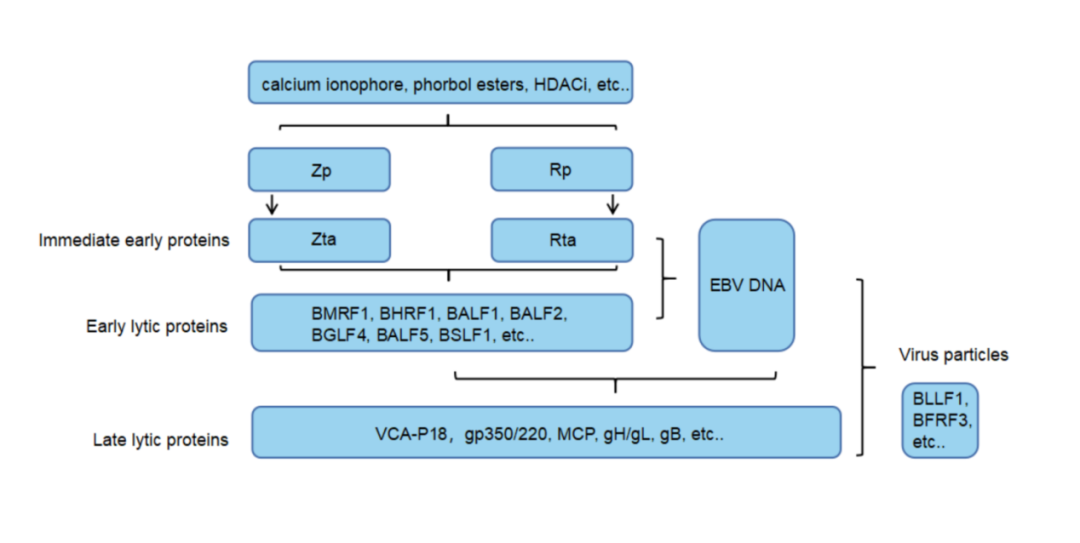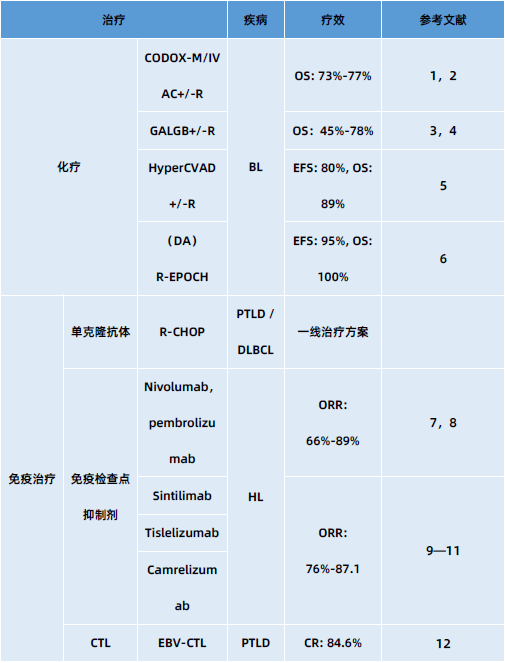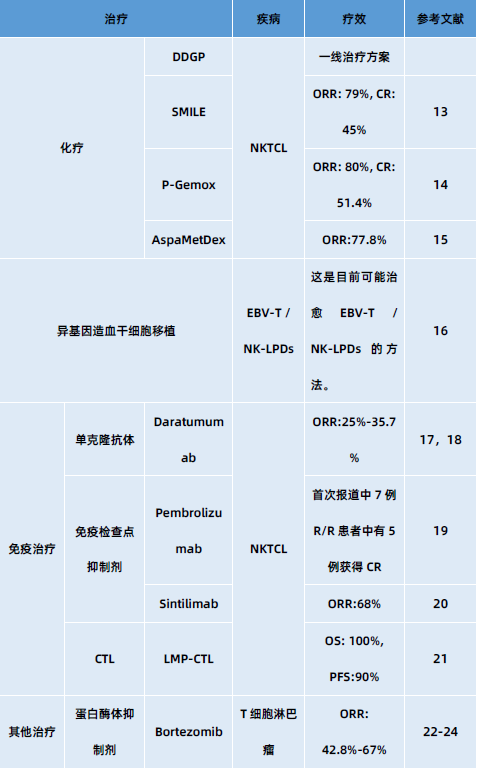
爱泼斯坦-巴尔病毒(EBV)可以侵入宿主的B淋巴细胞、T淋巴细胞和NK细胞,终生存活。EBV的长潜伏期和再激活会恶性转化,导致各种淋巴组织增殖性疾病(LPDs),包括EBV相关B细胞淋巴组织增殖性疾病(EBV-B-LPDs)(例如,伯基特淋巴瘤[BL]、经典型霍奇金淋巴瘤[cHL]以及移植后和HIV相关的淋巴组织增殖性疾病)和EBV相关T细胞淋巴组织增殖性疾病(EBV-T/NK-LPDs)(例如,结外鼻型自然杀伤细胞/T细胞淋巴瘤[ENKTCL]、侵袭性NK细胞白血病[ANKL]和外周T细胞淋巴瘤,非特指型[PTCL-NOS])。EBV-LPDs的治疗包括化疗、放疗和造血干细胞移植(HSCT)等。然而治疗方法有限,EBV-LPDs患者的生存预后不佳。该病毒在不同宿主细胞表达不同潜在的病毒蛋白和裂解蛋白,可以调控细胞周期和死亡过程,促进肿瘤细胞的存活(图1,图2)。基于这一机制,研究者开发了一系列新的治疗方法。南昌大学第一附属医院血液学中心李菲教授团队将EBV-LPDs治疗方法做一综述并发表于Frontiers in Oncology杂志,该综述第一作者为吕柯冰,通讯作者为李菲教授。小编将主要内容整理如下,供读者参考。


EBV几乎可在所有地方性BL病例和高达40%的免疫缺陷相关BL病例中被检测到。各种强化治疗方案在BL患者中表现出极大的活性,如CODOX-M/IVAC+/-R、CALGB、HCVAD+/-R,(DA)R-EPOCH等(表1)。然而,化疗无法达到阻止疾病活动和根除感染细胞的目的。复发性或难治性(R/R)BL患者缺乏进一步的抢救治疗方案。
EBV也在一些T或NK细胞淋巴瘤中被发现,在NK/T细胞淋巴瘤(NKTCL)中最为常见。基于L-天冬酰胺酶的方案,如SMILE,显示出良好的疗效,但毒性高,甚至可能导致患者死亡。DDGP、P-Gemox和AspaMetDex是毒性较小的替代品,取得了不错的效果(表2)。在T细胞淋巴瘤中,EBV+ PTCL-NOS将CHOP作为一线治疗方法,但仅凭此方案该疾病不能被治愈。
单克隆抗体
基于CD30、CD20、CD38在部分肿瘤细胞的表达,这三种靶点的靶向药物在EBV-LPDs中的应用研究较多(表1,表2)。
CD30可在EBV感染诱导的一些移植后淋巴增生性疾病(PTLD)中表达,包括DLBCL。PTLD对标准治疗反应不佳,维布妥昔单抗(BV)靶向CD30,是一种极具吸引力的治疗方法。Thomas Mika等人报道了第一例通过BV和过继性EBV-CTL联合长期控制高度侵袭性EBV-DLBCL的病例。患者在发生PTLD后3.5年没有疾病进展。BV对R/R NKTCL同样有效,一例R/R NKTCL患者接受BV四个周期后获得长期完全缓解(CR)。
EBV感染和CD20+ B细胞增殖能够在90%的PTLD病例中被观察到。因此抗CD20的单克隆抗体利妥昔单抗(Rituximab)可用于该疾病的标准治疗。有研究者指出,EBV感染患者使用该靶向药与消除PTLD相关的死亡率有关。同时,利妥昔单抗联合CHOP是EBV+DLBCL的一线治疗方法,已有不同反应的报道。
CD38是NKTCL的潜在治疗靶点。Wang L等人证明CD38阳性与不良预后显著相关。最新的一项2期研究中,32名R/R NKTCL患者应用达雷妥尤单抗(Daratumumab)后总体有效率(ORR)为25%,但反应持续时间短。因此仅达雷妥尤单抗不足以治疗具有侵袭性特征的患者。
检查点抑制剂
程序性死亡配体1(PD-L1)可结合T细胞上的PD-1受体以抑制T细胞免疫功能(图3)。cHL、PTLD以及NKTCL的恶性细胞都表达PD-L1,并且这种表达受到EBV的促进。纳武利尤单抗(Nivolumab)和帕博利珠单抗(Pembrolizumab)作为抗PD-1单克隆抗体,已经被美国食品药品监督管理局(FDA)批准用于治疗R/R HL。Kwong等人证实了帕博利珠单抗对NKTCL患者的疗效,7例晚期患者接受治疗后有5例获得CR。还有很多新的PD-1/L1抑制剂在HL、PTCL和NKTCL等患者群体中已有应用数据及结果参考(表1,2)。
EBV驱动潜伏膜蛋白LMP1过度表达,激活NF-κB/MAPK和JAK/STAT信号通路,从而导致PD-L1高表达。(图3)因此JAK1/2/3抑制剂也成为了研究和应用的热点。用JAK3抑制剂托法替尼(Tofacitinib)治疗EBV阳性T和NK细胞系可降低磷酸化STAT5水平,抑制增殖。

细胞毒性T淋巴细胞(CTL)
过继免疫疗法通过体外激活和扩增EBV-CTL注射到患者体内以重建免疫力。在大约40%的淋巴瘤患者中,肿瘤细胞表达的潜在蛋白LMP-1和LMP-2同样成为CTL的免疫治疗靶点。EBV-CTL与LMP-1/2-CTL在cHL、PTLD、NKTCL部分人群中有相关研究(表1,2)。然而,由于成本限制和技术困难,CTL通常在患者病情恶化后使用,尚未在临床上大规模应用。
国内外大量研究证明,异基因造血干细胞移植可以治疗EBV-T/NK-LPDs。2000年,首次有报告通过异基因骨髓移植治愈了一名CAEBV患者,同时根除了感染EBV的外周T细胞和NK细胞。一系列研究已经证明,接受Allo-HSCT的患者有明显的生存益处。然而,移植前有活动性疾病的患者预后较差,目前化疗不能解决该问题。尽管allo-HSCT可以治愈患者,但移植后并发症的风险很高,通常保留用于重症患者。
硼替佐米(Bortezomib)作为26S蛋白酶体抑制剂可保护抑制性蛋白IκBα并阻断NF-κB活化,导致恶性细胞凋亡。已有体内研究表明硼替佐米可诱导NK淋巴瘤/白血病细胞凋亡。单独或联合CHOP应用于T细胞淋巴瘤能够获得42.8%-67%的ORR(表2)。
总之,近年来EBV-LPDs的治疗取得了很大进展,从传统的化疗、免疫抑制剂和HSCT,到信号通路和病毒潜伏期及裂解周期的发现带来的免疫治疗和表观遗传学治疗。然而,大多数研究结果仅限于特定群体。对于EBV-LPDs的异质群体,免疫治疗靶点、检查点抑制剂、CTL、小分子靶点等仍然是难以捉摸的。我们希望,随着这些方法相关的数据和科学的成熟,后续可以提供单一治疗和联合治疗的替代疗法。
表1. EBV-B-LPDs的有效治疗方法总结

表2. EBV-T/NK-LPDs的有效治疗方法总结

参考文献:
1. Magrath I, Adde M, Shad A, et al. Adults and children with small non-cleaved-cell lymphoma have a similar excellent outcome when treated with the same chemotherapy regimen. Journal of clinical oncology : official journal of the American Society of Clinical Oncology. (1996)14(3):925-34.
2. Barnes JA, Lacasce AS, Feng Y, et al. Evaluation of the addition of rituximab to CODOX-M/IVAC for Burkitt's lymphoma: a retrospective analysis. Annals of oncology : official journal of the European Society for Medical Oncology. (2011)22(8):1859-64.
3. Rizzieri DA, Johnson JL, Byrd JC, et al. Improved efficacy using rituximab and brief duration, high intensity chemotherapy with filgrastim support for Burkitt or aggressive lymphomas: cancer and Leukemia Group B study 10 002. British journal of haematology. (2014)165(1):102-11.
4. Rizzieri DA, Johnson JL, Niedzwiecki D, et al. Intensive chemotherapy with and without cranial radiation for Burkitt leukemia and lymphoma: final results of Cancer and Leukemia Group B Study 9251. Cancer. (2010)100(7):1438-48
5. Thomas DA, Faderl S, O'Brien S, et al. Chemoimmunotherapy with hyper-CVAD plus rituximab for the treatment of adult Burkitt and Burkitt-type lymphoma or acute lymphoblastic leukemia. Cancer. (2006)106(7):1569-80.
6. Dunleavy K, Pittaluga S, Shovlin M, et al. Low-intensity therapy in adults with Burkitt's lymphoma. N Engl J Med. (2013)369(20):1915-25.
7. Younes A, Santoro A, Shipp M, et al. Nivolumab for classical Hodgkin's lymphoma after failure of both autologous stem-cell transplantation and brentuximab vedotin: a multicentre, multicohort, single-arm phase 2 trial. Lancet Oncology. (2016)17(9):1283-94.
8. Chen R, Zinzani PL, Fanale MA, et al. Phase II Study of the Efficacy and Safety of Pembrolizumab for Relapsed/Refractory Classic Hodgkin Lymphoma. Journal of Clinical Oncology. (2017).
9. Pys A, Phs C, Pys D, et al. Safety and activity of sintilimab in patients with relapsed or refractory classical Hodgkin lymphoma (ORIENT-1): a multicentre, single-arm, phase 2 trial. The Lancet Haematology. (2019)6(1):e12-e9.
10. Song Y, Gao Q, Zhang H, et al. Treatment of relapsed or refractory classical Hodgkin lymphoma with the anti-PD-1, tislelizumab: results of a phase 2, single-arm, multicenter study. Leukemia. (2020)34(2):533-42.
11. Song Y, Wu J, Chen X. A Single-Arm, Multicenter, Phase II Study of Camrelizumab in Relapsed or Refractory Classical Hodgkin Lymphoma. Clinical Cancer Research. (2019)25(18):7363-956. Armand, P. Immune checkpoint blockade in hematologic malignancies. Blood. (2015)125(22):3393-400.
12. Chen BJ, Chapuy B, Ouyang J, et al. PD-L1 Expression Is Characteristic of a Subset of Aggressive B-cell Lymphomas and Virus-Associated Malignancies. Clinical Cancer Research An Official Journal of the American Association for Cancer Research. (2013)19(13):3462-73.
13. Yamaguchi M, Kwong YL, Kim WS. Phase II Study of SMILE Chemotherapy for Newly Diagnosed Stage IV, Relapsed, or Refractory Extranodal Natural Killer (NK)/T-Cell Lymphoma, Nasal Type: The NK-Cell Tumor Study Group Study. Journal of Clinical Oncology. (2011)29(33):4410-6.
14. Li X, Cui Y, Sun Z, et al. DDGP versus SMILE in Newly Diagnosed Advanced Natural Killer/T-Cell Lymphoma: A Randomized Controlled, Multicenter, Open-label Study in China. Clinical Cancer Research. (2016):5223-8.
15. Wang JH, Wang L, Liu CC, et al. Efficacy of combined gemcitabine, oxaliplatin and pegaspargase (P-gemox regimen) in patients with newly diagnosed advancedstage or relapsed/refractory extranodal NK/T-cell lymphoma. Oncotarget. (2016)7(20).
16. Yonese I, Sakashita C, Imadome KI, et al. Nationwide survey of systemic chronic active EBV infection in Japan in accordance with the new WHO classification - ScienceDirect. (2020).
17. Lv K, Li X, Yu H. Selection of new immunotherapy targets for NK/T cell lymphoma. American Journal of Translational Research. (2020)12(11):7034-47.
18. Huang H, Zhu J, Yao M, et al. Daratumumab monotherapy for patients with relapsed or refractory natural killer/T-cell lymphoma, nasal type: an open-label, single-arm, multicenter, phase 2 study. Journal of hematology & oncology. (2021)14(1):25.
19. Jaccard, Arnaud, Hermine, Olivier. A major turning point in NK/T-cell lymphoma? Blood the Journal of the American Society of Hematology. (2017).
20. Tao R, Fan L, Song Y, et al. Sintilimab for relapsed/refractory extranodal NK/T cell lymphoma: a multicenter, single-arm, phase 2 trial (ORIENT-4). Signal transduction and targeted therapy. (2021)6(1):365.
21. Seok-Goo, Cho, Nayoun, Kim, et al. Long-term Outcome of Extranodal NK/T Cell Lymphoma Patients Treated With Postremission Therapy Using EBV LMP1 and LMP2a-specific CTLs. Molecular Therapy. (2015).
22. Lee, Suh, Kang, B-Y, Ryoo, Huh. Phase I study of proteasome inhibitor bortezomib plus CHOP in patients with advanced, aggressive T-cell or NK/T-cell lymphoma. Annals of Oncology Official Journal of the European Society for Medical Oncology. (2008).
23. Zinzani PL, Musuraca G, Tani M. Phase II Trial of Proteasome Inhibitor Bortezomib in Patients With Relapsed or Refractory Cutaneous T-Cell Lymphoma. Journal of Clinical Oncology. (2007)25(27):4293-7.
24. Farid M, Yau YW, Tay K. et al. A promising new regimen for the treatment of advanced extranodal NK/T cell lymphoma. Acta Oncologica. (2011)50(4):589.











 苏公网安备32059002004080号
苏公网安备32059002004080号


